2013 Peugeot 3008 Hybrid 4 tow
[x] Cancel search: towPage 5 of 340
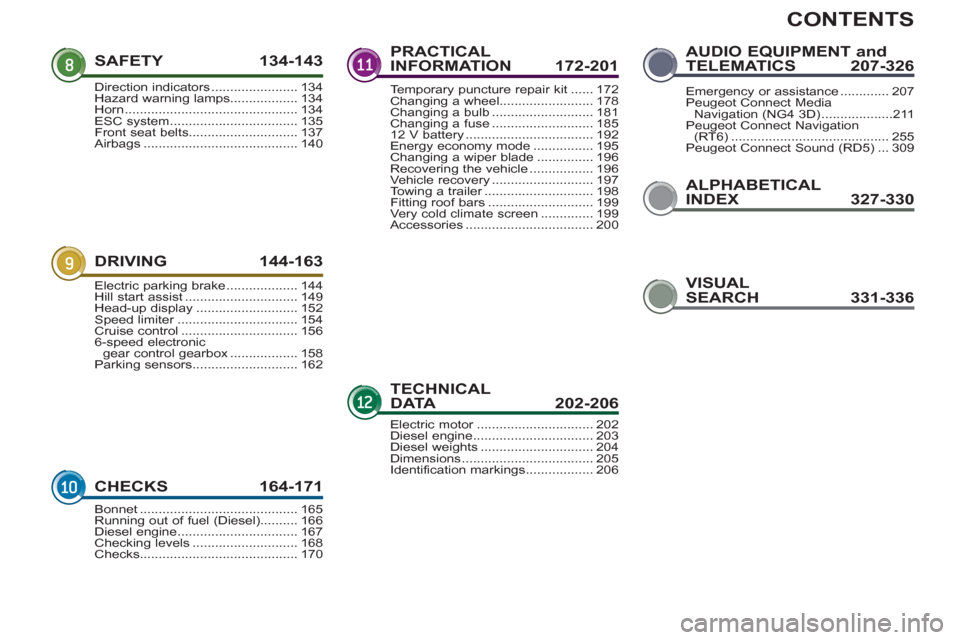
CONTENTS
ALPHABETICAL
INDEX 327-330 SAFETY 134-14
3
DRIVING 144-163
CHECKS 164-171
PRACTICAL
INFORMATION 172-201
TECHNICALDATA 202-206
AUDIO EQUIPMENT andTELEMATICS 207-326
Direction indicators.......................134Hazard warning lamps..................134Horn..............................................134ESC system ..................................135Front seat belts.............................137Airbags.........................................140
Electric parking brake ...................144Hill start assist..............................149Head-up display...........................152Speed limiter................................r154Cruise control...............................1566-speed electronic
gear control gearbox..................158Parking sensors ............................162
Bonnet..........................................165Running out of fuel (Diesel)..........166Diesel engine................................167Checking levels............................168Checks..........................................170
Temporary puncture repair kit......172Changing a wheel.........................178Changing a bulb...........................181Changing a fuse ...........................18512 V battery ..................................192Energy economy mode................195Changing a wiper blade...............196Recovering the vehicle.................196Vehicle recovery ...........................197Towing a trailer.............................r198Fitting roof bars............................199Very cold climate screen..............199Accessories..................................200
Electric motor...............................r202Diesel engine................................203Diesel weights ..............................204Dimensions ...................................205Identification markings..................206
VISUAL
SEARCH 331-336
Emergency or assistance.............207Peugeot Connect Media
Navigation (NG4 3D)...................211Peugeot Connect Navigation(RT6) ..........................................255Peugeot Connect Sound (RD5)...309
Page 24 of 340
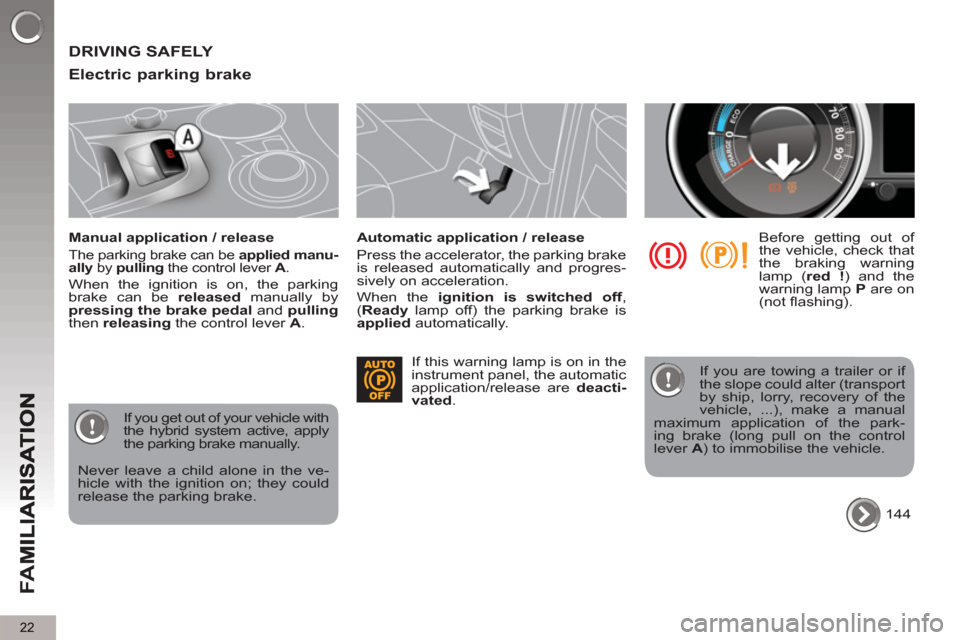
22
FA
M
DRIVING SAFELY
Electric parkin
g brake
Manual application / release
The parking brake can be applied manu-
ally
by pulling
the control lever A
.
When the ignition is on, the parking
brake can be released
manually by
pressing the brake pedal
and pulling
then releasing
the control lever A
.
Automatic application / release
Press the accelerator, the parking brake
is released automatically and progres-
sively on acceleration.
When the ignition is switched off
,
( Ready
lamp off) the parking brake is
applied
automatically.
If you get out of your vehicle with
the hybrid system active, apply
the parking brake manually.
Before getting out of
the vehicle, check that
the braking warning
lamp ( red !
) and the
warning lamp P
are on
(not fl ashing).
Never leave a child alone in the ve-
hicle with the ignition on; they could
release the parking brake.
144 If this warning lamp is on in the
instrument panel, the automatic
application/release are deacti-
vated
.
If you are towing a trailer or if
the slope could alter (transport
by ship, lorry, recovery of the
vehicle, ...), make a manual
maximum application of the park-
ing brake (long pull on the control
lever A
) to immobilise the vehicle.
Page 41 of 340
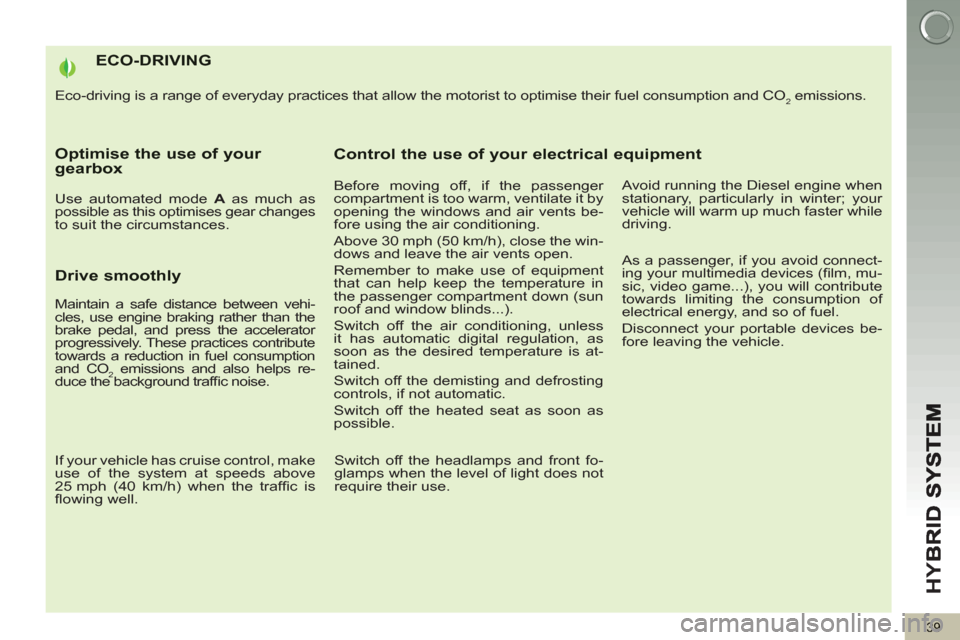
HY
B
39
ECO-DRIVING
Eco-driving is a range of everyday practices that allow the motorist to optimise their fuel consumption and CO2 emissions.
Optimise the use of your gearbox
Use automated mode A
as much as
possible as this optimises gear changes
to suit the circumstances.
Drive smoothly
If your vehicle has cruise control, make
use of the system at speeds above
25 mph (40 km/h) when the traffi c is
fl owing well.
Control the use of your electrical equipment
Before moving off, if the passenger
compartment is too warm, ventilate it by
opening the windows and air vents be-
fore using the air conditioning.
Above 30 mph (50 km/h), close the win-
dows and leave the air vents open.
Remember to make use of equipment
that can help keep the temperature in
the passenger compartment down (sun
roof and window blinds...).
Switch off the air conditioning, unless
it has automatic digital regulation, as
soon as the desired temperature is at-
tained.
Switch off the demisting and defrosting
controls, if not automatic.
Switch off the heated seat as soon as
possible.
Switch off the headlamps and front fo-
glamps when the level of light does not
require their use.
Avoid running the Diesel engine when
stationary, particularly in winter; your
vehicle will warm up much faster while
driving.
As a passenger, if you avoid connect-
ing your multimedia devices (fi lm, mu-
sic, video game...), you will contribute
towards limiting the consumption of
electrical energy, and so of fuel.
Disconnect your portable devices be-
fore leaving the vehicle.
Maintain a safe distance between vehi-
cles, use engine braking rather than the
brake pedal, and press the accelerator
progressively. These practices contribute
towards a reduction in fuel consumption
and CO
2 emissions and also helps re-
duce the background traffi c noise.
Page 48 of 340
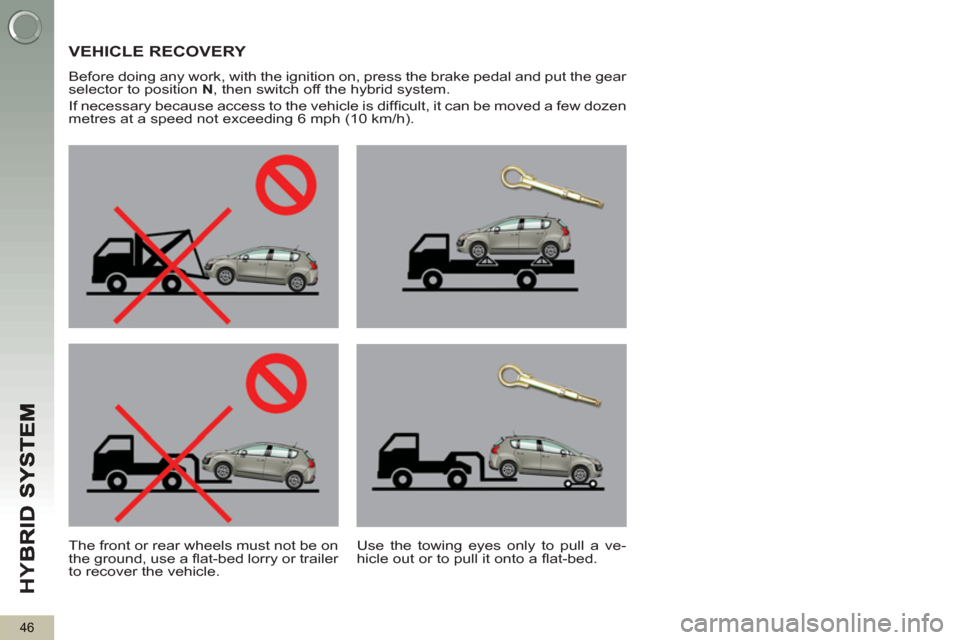
HY
B
46
VEHICLE RECOVERY
Before doing any work, with the ignition on, press the brake pedal and put the gear
selector to position N
, then switch off the hybrid system.
If necessary because access to the vehicle is diffi cult, it can be moved a few dozen
metres at a speed not exceeding 6 mph (10 km/h).
The front or rear wheels must not be on
the ground, use a fl at-bed lorry or trailer
to recover the vehicle.
Use the towing eyes only to pull a ve-
hicle out or to pull it onto a fl at-bed.
Page 52 of 340
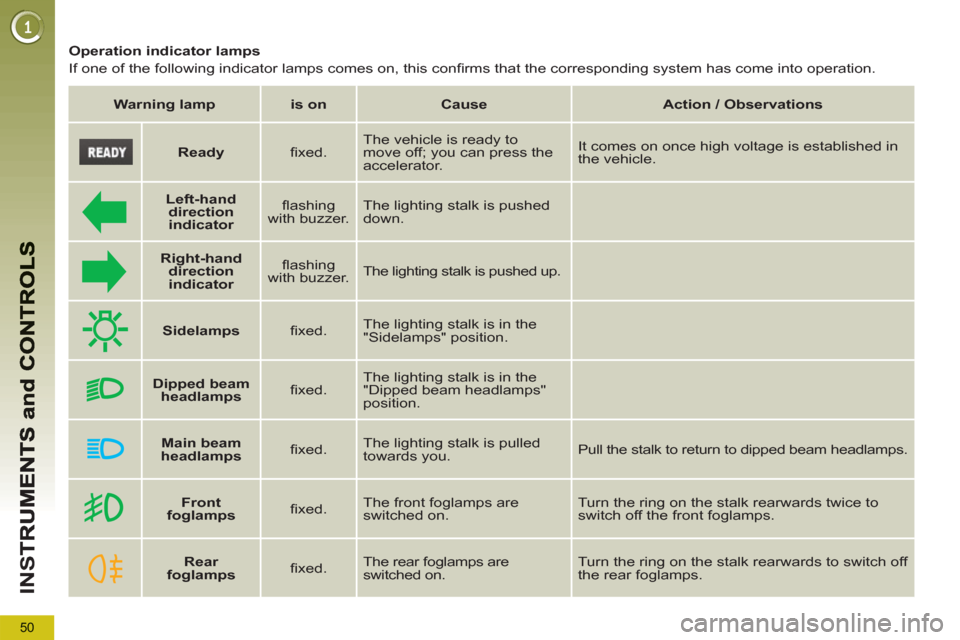
50
IN
S
Operation indicator lamps
If one of the following indicator lamps comes on, this confi rms that the corresponding system has come into operation.
Warning lamp
is on
Cause
Action / Observations
Left-hand
direction
indicato
r
fl ashing
with buzzer. The lighting stalk is pushed
down.
Right-hand
direction
indicator
fl ashing
with buzzer. The lighting stalk is pushed up.
Sidelamps
fi xed. The lighting stalk is in the
"Sidelamps" position.
Dipped beam
headlamps
fi xed. The lighting stalk is in the
"Dipped beam headlamps"
position.
Main beam
headlamps
fi xed. The lighting stalk is pulled
towards you. Pull the stalk to return to dipped beam headlamps.
Ready
fi xed. The vehicle is ready to
move off; you can press the
accelerator. It comes on once high voltage is established in
the vehicle.
Front
foglamps
fi xed. The front foglamps are
switched on. Turn the ring on the stalk rearwards twice to
switch off the front foglamps.
Rear
foglamps
fi xed. The rear foglamps are
switched on. Turn the ring on the stalk rearwards to switch off
the rear foglamps.
Page 69 of 340
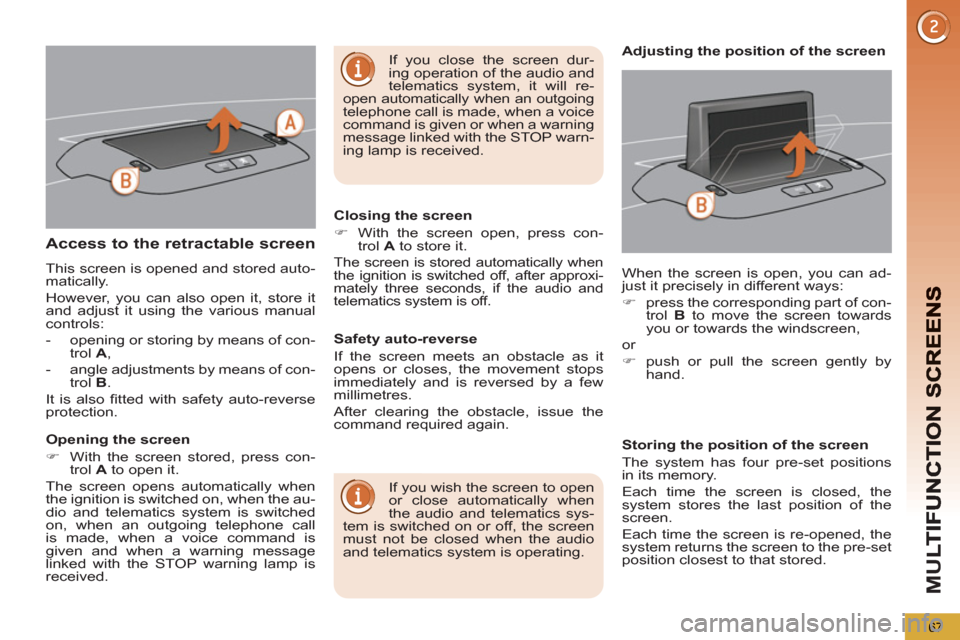
M
U
67
Access to the retractable screen
This screen is opened and stored auto-
matically.
However, you can also open it, store it
and adjust it using the various manual
controls:
- opening or storing by means of con-
trol A
,
- angle adjustments by means of con-
trol B
.
It is also fi tted with safety auto-reverse
protection.
Opening the screen
�)
With the screen stored, press con-
trol A
to open it.
The screen opens automatically when
the ignition is switched on, when the au-
dio and telematics system is switched
on, when an outgoing telephone call
is made, when a voice command is
given and when a warning message
linked with the STOP warning lamp is
received.
Closing the screen
�)
With the screen open, press con-
trol A
to store it.
The screen is stored automatically when
the ignition is switched off, after approxi-
mately three seconds, if the audio and
telematics system is off.
If you wish the screen to open
or close automatically when
the audio and telematics sys-
tem is switched on or off, the screen
must not be closed when the audio
and telematics system is operating. When the screen is open, you can ad-
just it precisely in different ways:
�)
press the corresponding part of con-
trol B
to move the screen towards
you or towards the windscreen,
or
�)
push or pull the screen gently by
hand.
Adjusting the position of the screen
Safety auto-reverse
If the screen meets an obstacle as it
opens or closes, the movement stops
immediately and is reversed by a few
millimetres.
After clearing the obstacle, issue the
command required again.
Storing the position of the screen
The system has four pre-set positions
in its memory.
Each time the screen is closed, the
system stores the last position of the
screen.
Each time the screen is re-opened, the
system returns the screen to the pre-set
position closest to that stored.
If you close the screen dur-
ing operation of the audio and
telematics system, it will re-
open automatically when an outgoing telephone call is made, when a voice
command is given or when a warning
message linked with the STOP warn-
ing lamp is received.
Page 74 of 340
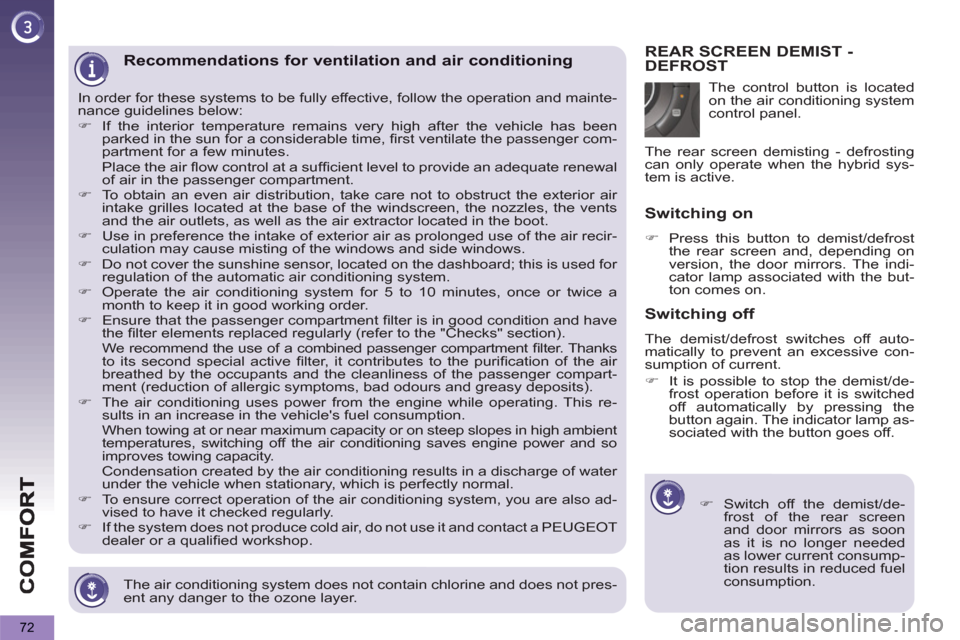
72
The air conditioning system does not contain chlorine and does not pres-
ent any danger to the ozone layer.
Recommendations for ventilation and air conditioning
In order for these systems to be fully effective, follow the operation and mainte-
nance guidelines below:
�)
If the interior temperature remains very high after the vehicle has been
parked in the sun for a considerable time, fi rst ventilate the passenger com-
partment for a few minutes.
Place the air fl ow control at a suffi cient level to provide an adequate renewal
of air in the passenger compartment.
�)
To obtain an even air distribution, take care not to obstruct the exterior air
intake grilles located at the base of the windscreen, the nozzles, the vents
and the air outlets, as well as the air extractor located in the boot.
�)
Use in preference the intake of exterior air as prolonged use of the air recir-
culation may cause misting of the windows and side windows.
�)
Do not cover the sunshine sensor, located on the dashboard; this is used for
regulation of the automatic air conditioning system.
�)
Operate the air conditioning system for 5 to 10 minutes, once or twice a
month to keep it in good working order.
�)
Ensure that the passenger compartment fi lter is in good condition and have
the fi lter elements replaced regularly (refer to the "Checks" section).
We recommend the use of a combined passenger compartment fi lter. Thanks
to its second special active fi lter, it contributes to the purifi cation of the air
breathed by the occupants and the cleanliness of the passenger compart-
ment (reduction of allergic symptoms, bad odours and greasy deposits).
�)
The air conditioning uses power from the engine while operating. This re-
sults in an increase in the vehicle's fuel consumption.
When towing at or near maximum capacity or on steep slopes in high ambient
temperatures, switching off the air conditioning saves engine power and so
improves towing capacity.
Condensation created by the air conditioning results in a discharge of water
under the vehicle when stationary, which is perfectly normal.
�)
To ensure correct operation of the air conditioning system, you are also ad-
vised to have it checked regularly.
�)
If the system does not produce cold air, do not use it and contact a PEUGEOT
dealer or a qualifi ed workshop. The control button is located
on the air conditioning system
control panel.
REAR SCREEN DEMIST - DEFROST
�)
Switch off the demist/de-
frost of the rear screen
and door mirrors as soon
as it is no longer needed
as lower current consump-
tion results in reduced fuel
consumption.
Switching on
�)
Press this button to demist/defrost
the rear screen and, depending on
version, the door mirrors. The indi-
cator lamp associated with the but-
ton comes on.
Switching off
The demist/defrost switches off auto-
matically to prevent an excessive con-
sumption of current.
�)
It is possible to stop the demist/de-
frost operation before it is switched
off automatically by pressing the
button again. The indicator lamp as-
sociated with the button goes off.
The rear screen demisting - defrosting
can only operate when the hybrid sys-
tem is active.
Page 76 of 340
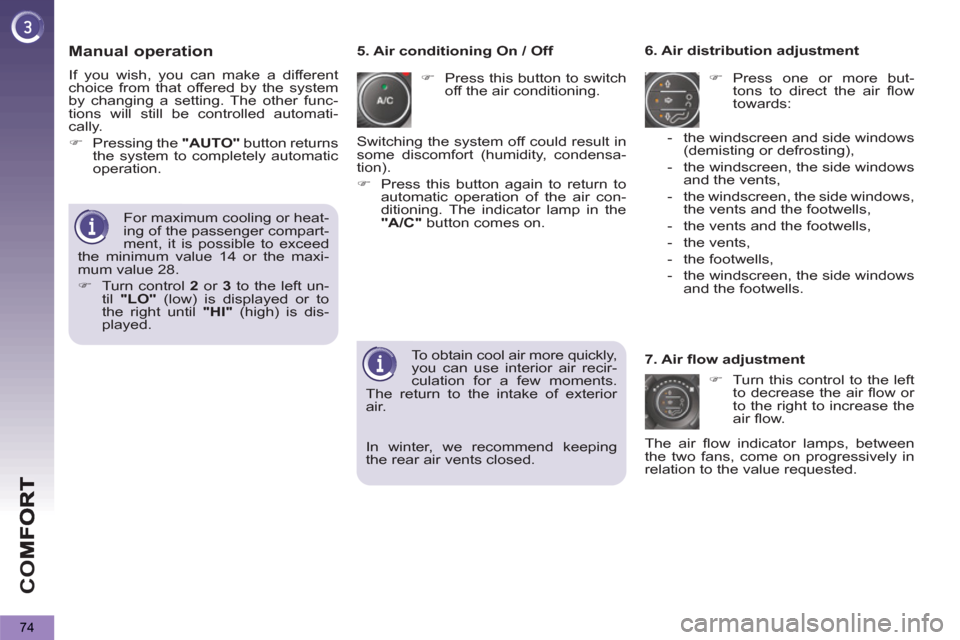
CO
74
Manual operation
�)
Press this button to switch
off the air conditioning.
6. Air distribution adjustment
�)
Press one or more but-
tons to direct the air fl ow
towards:
7. Air fl ow adjustment
�)
Turn this control to the left
to decrease the air fl ow or
to the right to increase the
air fl ow.
5. Air conditioning On / Off
- the windscreen and side windows
(demisting or defrosting),
- the windscreen, the side windows
and the vents,
- the windscreen, the side windows,
the vents and the footwells,
- the vents and the footwells,
- the vents,
- the footwells,
- the windscreen, the side windows
and the footwells.
The air fl ow indicator lamps, between
the two fans, come on progressively in
relation to the value requested.
For maximum cooling or heat-
ing of the passenger compart-
ment, it is possible to exceed
the minimum value 14 or the maxi-
mum value 28.
�)
Turn control 2
or 3
to the left un-
til "LO"
(low) is displayed or to
the right until "HI"
(high) is dis-
played.
Switching the system off could result in
some discomfort (humidity, condensa-
tion).
�)
Press this button again to return to
automatic operation of the air con-
ditioning. The indicator lamp in the
"A/C"
button comes on.
To obtain cool air more quickly,
you can use interior air recir-
culation for a few moments.
The return to the intake of exterior
air.
If you wish, you can make a different
choice from that offered by the system
by changing a setting. The other func-
tions will still be controlled automati-
cally.
�)
Pressing the "AUTO"
button returns
the system to completely automatic
operation.
In winter, we recommend keeping
the rear air vents closed.